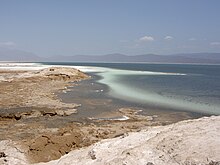高鹽湖泊
高鹽湖泊(簡稱鹽湖)是一種含有顯著濃度的氯化鈉或其他鹽的陸封水體,其鹽含量超過了海洋水(3.5%,即35克/升或0.29磅/美加侖)。少部分的微生物和甲殼類物種可在這種高鹽度環境中茁壯成長,但這種環境對大多數生命體是不適宜的[1]。其中一些物種在乾燥時進入休眠狀態,有些物種推估生存了超過2.5億年[2]。由於鹽含量高,因此高鹽湖泊的水面浮力很高。

世界上最鹹的水體是位於南極麥克默多乾燥谷唐胡安池。其體積約為3000立方米,但正不斷變化中。唐胡安池的鹽度水平超過44%[3](即比海水高12倍)。即使溫度低於-50°C(-58°F)[3],其高鹽度也會令唐胡安池不會凍結。麥克默多乾燥谷中有其他高鹽度水體,如萬塔湖,其鹽度超過35%(即比海水高10倍)。他們在冬天會被冰覆蓋。
南極洲以外最高鹽的湖泊是位於吉布提的阿薩勒湖[4],其鹽度為34.8%(即比海水高10倍)。世界上最著名的高鹽湖泊是死海(2010年為34.2%的鹽度)和大鹽湖(5-27%的可變鹽度)。死海將以色列和巴勒斯坦西岸與約旦分開,是世界上最深的高鹽湖泊,而阿拉魯阿馬潟湖是世界上最大的高鹽湖泊[5]。位於猶他州的大鹽湖在面積上約是死海的三倍大,但比死海更淺,水位波動較大,其鹽度在最低紀錄水位時,為海水鹽度的7.7倍,但當水位高時,其鹽度僅下降到略高於海洋。[6][7][8]
參看
編輯參考文獻
編輯- ^ Hammer, Ulrich T. Saline lake ecosystems of the world. Springer. 1986. ISBN 90-6193-535-0.
- ^ Vreeland, R.H.; Rosenzweig, W.D. & Powers, D.W. Isolation of a 250 million-year-old halotolerant bacterium from a primary salt crystal. Nature. 2000, 407 (6806): 897–900 [2017-07-05]. PMID 11057666. doi:10.1038/35038060. (原始內容存檔於2017-03-19).
- ^ 3.0 3.1 Marion, G.M. A theoretical evaluation of mineral stability in Don Juan Pond, Wright Valley, Victoria Land. Antarctic Science. 1997, 9: 92–99 [2017-07-05]. doi:10.1017/S0954102097000114. (原始內容存檔於2016-03-04).
- ^ Quinn, Joyce A.; Woodward, Susan L. (編). Earth's Landscape: An Encyclopedia of the World's Geographic Features [2 volumes]. ABC-CLIO. 2015: 9. ISBN 978-1-61069-446-9.
- ^ Goetz, P.W. (編). The New Encyclopædia Britannica 3 15th: 937. 1986.
- ^ Wilkerson, Christine. Utah's Great Salt Lake and Ancient Lake Bonneville, PI39 – Utah Geological Survey. Geology.utah.gov. [2010-08-03]. (原始內容存檔於2010-08-15).
- ^ Allred, Ashley; Baxter, Bonnie. Microbial life in hypersaline environments. Science Education Resource Center at Carleton College. [2010-06-17]. (原始內容存檔於2017-12-25).
- ^ Kjeldsen, K.U.; Loy, A.; Jakobsen, T.F.; Thomsen, T.R.; et al. Diversity of sulfate-reducing bacteria from an extreme hypersaline sediment, Great Salt Lake (Utah). FEMS Microbiol. Ecol. (U.S. National Library of Medicine, National Institutes of Health). May 2007, 60 (2): 287–298. PMID 17367515. doi:10.1111/j.1574-6941.2007.00288.x.
- ^ Shadrin, N.V. The Crimean hypersaline lakes: towards development of scientific basis of integrated sustainable management (PDF). Institute of Biology of the Southern Seas. 2009 [2015-02-20]. (原始內容 (PDF)存檔於2015年2月20日).